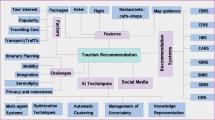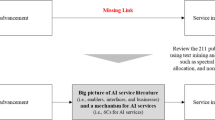Abstract
The strong integration of technology in the physical world caused the emergence of smart environments. These environments are supposed to improve the quality of life of their users by providing them with customized services when needed and adapting to their changing needs. The dynamics of the users, the huge number of available services and the strong collaboration between the stakeholders, make traditional service-oriented approaches incapable of providing relevant services to the users in these environments. To deal with these issues, we propose a recommendation-based system for service composition targeting smart environments. The proposed system is able to capture the situation of the users through the analysis of their context information, which in turn allows the system to capture their requirements and select the appropriate service models to satisfy their needs. Then, based on the invocation log, the system implements two recommendation policies. First, it selects the best services in terms of QoS that satisfy the captured requirements. Second, the system recommends new tasks to be integrated in existing service models. The conducted experiments show the efficiency and effectiveness of the recommendation policies proposed. To illustrate the workings of the proposed system, we present a case study called SMARTROAD pertaining to the transport domain and road security.







Similar content being viewed by others
References
Kondepudi SN, Ramanarayanan V, Jain A, Singh GN, Nitin Agarwal NK, Kumar R, Singh R, Bergmark P, Hashitani T, Gemma P et al (2014) Smart sustainable cities analysis of definitions. The ITU-T focus group for smart sustainable cities
DESA United Nations (2015) World urbanization prospects: the 2014 revision. United Nations Department of Economics and Social Affairs, Population Division, New York, NY, USA
Schaffers H, Komninos N, Pallot M, Trousse B, Nilsson M, Oliveira A (2011) Smart cities and the future internet: towards cooperation frameworks for open innovation. In: The future internet. Springer, Berlin, pp 431–446
Bieberstein N, Bose S, Walker L, Lynch A (2005) Impact of service-oriented architecture on enterprise systems, organizational structures, and individuals. IBM Syst J 44(4):691–708
Baresi L, Di Nitto E, Ghezzi C, Guinea S (2007) A framework for the deployment of adaptable web service compositions. Serv Oriented Comput Appl 1(1):75–91
Hashem IAT, Chang V, Anuar NB, Ibrar Yaqoob KA, Gani A, Ahmed E, Chiroma H (2016) The role of big data in smart city. Int J Inf Manag 36(5):748–758
Zheng Z, Zhang Y, Lyu MR (2014) Investigating qos of real-world web services. IEEE Trans Serv Comput 7(1):32–39
Jin X, Chun S, Jung J, Lee K-H (2017) A fast and scalable approach for iot service selection based on a physical service model. Inf Syst Front 19(6):1357–1372
Sheng QZ, Qiao X, Vasilakos AV, Szabo C, Bourne S, Xiaofei X (2014) Web services composition: a decade’s overview. Inf Sci 280:218–238
Casati F, Shan M-C (2001) Dynamic and adaptive composition of e-services. Inf Syst 26(3):143–163
Fang J, Hu S, Han Y (2004) A service interoperability assessment model for service composition. In: IEEE international conference on services computing, 2004 (SCC 2004). Proceedings. 2004, pp 153–158
Konstan JA, Riedl J (2012) Recommender systems: from algorithms to user experience. User Model User Adapt Interact 22(1):101–123
Schafer JB, Frankowski D, Herlocker J, Sen S (2007) Collaborative filtering recommender systems. In: The adaptive web. Springer, pp 291–324
Resnick P, Iacovou N, Suchak M, Bergstrom P, Riedl J (1994) Grouplens: an open architecture for collaborative filtering of netnews. In: Proceedings of the 1994 ACM conference on computer supported cooperative work. CSCW ’94. ACM, New York, NY, USA, pp 175–186
Candillier L, Meyer F, Boullé M (2007) Comparing state-of-the-art collaborative filtering systems. In: Petra P (ed) Machine learning and data mining in pattern recognition. Springer, Berlin, pp 548–562
Koren Y, Bell R, Volinsky C (2009) Matrix factorization techniques for recommender systems. Computer 42(8):30–37
Lee M, Choi P, Woo Y (2002) A hybrid recommender system combining collaborative filtering with neural network. In: International conference on adaptive hypermedia and adaptive web-based systems. Springer, pp 531–534
Bobadilla J, Ortega F, Hernando A, Alcalá J (2011) Improving collaborative filtering recommender system results and performance using genetic algorithms. Knowl Based Syst 24(8):1310–1316
Aggarwal CC, Wolf JL, Wu K-L, Yu PS (1999) Horting hatches an egg: a new graph-theoretic approach to collaborative filtering. In: Proceedings of the fifth ACM SIGKDD international conference on knowledge discovery and data mining, KDD ’99. ACM, New York, NY, USA, pp 201–212
Son J, Kim SB (2017) Content-based filtering for recommendation systems using multiattribute networks. Expert Syst Appl 89:404–412
Burke R (2002) Hybrid recommender systems: survey and experiments. User Model User Adapt Interact 12(4):331–370
Abowd GD, Dey AK, Brown PJ, Davies N, Smith M, Steggles P (1999) Towards a better understanding of context and context-awareness. In: International symposium on handheld and ubiquitous computing. Springer, pp 304–307
Pinheiro MK, Souveyet C (2018) Supporting context on software applications: a survey on context engineering. Modélisation et utilisation du contexte 2(1):1–29. https://doi.org/10.21494/ISTE.OP.2018.0275
World Health Organization et al (2018) Global status report on road safety 2018. World Health Organization, Geneva
National Committee for the Prevention of Traffic Accidents (Morocco). Provisional assessment of road accidents for 2017, 2016
Chang J, Yao W, Li X (2017) The design of a context-aware service system in intelligent transportation system. Int J Distrib Sens Netw 13(10):1550147717738165
Ait-Cheik-Bihi W, Nait-Sidi-Moh A, Bakhouya M, Gaber J, Wack M (2012) Transportml platform for collaborative location-based services. Serv Oriented Comput Appl 6(4):363–378
Dijkstra EW (1982) On the role of scientific thought. In: Selected writings on computing: a personal perspective. Springer, Berlin, pp 60–66. ISBN 0-387-90652-5
OMG (2014) Meta object facility meta object facility (MOF) core specification. Adopted Specification, OMG document formal/14-04-03. https://www.omg.org/spec/MOF/2.4.2
Faieq S, Saidi R, Elghazi H, Rahmani MD (2017) A conceptual architecture for a cloud-based context-aware service composition. In: Advances in ubiquitous networking 2. Springer, Singapore, pp 235–246
Gu Q, Lago P (2009) Exploring service-oriented system engineering challenges: a systematic literature review. Serv Orient Comput Appl 3(3):171–188
Chengyuan Y, Huang L (2016) A web service qos prediction approach based on time- and location-aware collaborative filtering. Serv Oriented Comput Appl 10(2):135–149
Sedhain S, Menon AK, Sanner S, Xie L (2015) Autorec: autoencoders meet collaborative filtering. In: Proceedings of the 24th international conference on world wide web, WWW ’15 Companion. ACM, New York, NY, USA, pp 111–112
Stone VM (2008) The auto-associative neural network—a network architecture worth considering. In: 2008 world automation congress, pp 1–4
Han J, Pei J, Yin Y (2000) Mining frequent patterns without candidate generation. In: Proceedings of the 2000 ACM SIGMOD international conference on management of data, SIGMOD’00. ACM, New York, NY, USA, pp 1–12
Garg K, Kumar D (2013) Comparing the performance of frequent pattern mining algorithms. Int J Comput Appl 69(25):21–28
WSDREAM team (2011) Ws-dream: A package of open source-code and datasets to benchmark QoS prediction approaches of web services
Zheng Z, Ma H, Lyu MR, King I (2011) Qos-aware web service recommendation by collaborative filtering. IEEE Trans Serv Comput 4(2):140–152
Wu J, Chen L, Feng Y, Zheng Z, Zhou MC, Wu Z (2013) Predicting quality of service for selection by neighborhood-based collaborative filtering. IEEE Trans Syst Man Cybern Syst 43(2):428–439
Sun H, Zheng Z, Chen J, Lyu MR (2013) Personalized web service recommendation via normal recovery collaborative filtering. IEEE Trans Serv Comput 6(4):573–579
Zheng Z, Ma H, Lyu MR, King I (2013) Collaborative web service qos prediction via neighborhood integrated matrix factorization. IEEE Trans Serv Comput 6(3):289–299
Zhang Y, Zheng Z, Lyu MR (2011) Exploring latent features for memory-based qos prediction in cloud computing. In: 2011 IEEE 30th international symposium on reliable distributed systems, pp 1–10
Yu D, Liu Y, Xu Y, Yin Y (2014) Personalized QoS prediction for web services using latent factor models. In: 2014 IEEE international conference on services computing, pp 107–114
Chen X, Liu X, Huang Z, Sun H (2010) Regionknn: a scalable hybrid collaborative filtering algorithm for personalized web service recommendation. In: 2010 IEEE international conference on web services, pp 9–16
Tang M, Jiang Y, Liu J, Liu X (2012) Location-aware collaborative filtering for QoS-based service recommendation. In: 2012 IEEE 19th international conference on web services, pp 202–209
Lo W, Yin J, Deng S, Li Y, Wu Z (2012) Collaborative web service GOS prediction with location-based regularization. In: 2012 IEEE 19th international conference on web services, pp 464–471
Chen X, Zheng Z, Yu Q, Lyu MR (2014) Web service recommendation via exploiting location and qos information. IEEE Trans Parallel Distrib Syst 25(7):1913–1924
He P, Zhu J, Zheng Z, Xu J, Lyu MR (2014) Location-based hierarchical matrix factorization for web service recommendation. In: 2014 IEEE international conference on web services, pp 297–304
Salakhutdinov R, Mnih A (2007) Probabilistic matrix factorization. In: Proceedings of the 20th international conference on neural information processing systems, NIPS’07. Curran Associates Inc, USA, pp 1257–1264
Lee Daniel D, Seung, H. Sebastian (2000) Algorithms for non-negative matrix factorization. In: Proceedings of the 13th international conference on neural information processing systems, NIPS’00. MIT Press, Cambridge, MA, USA, pp 535–541
Rao J, Su X (2005) A survey of automated web service composition methods. In: Semantic web services and web process composition. Springer, Berlin, pp 43–54
Wu D, Parsia B, Sirin E, Hendler J, Nau D (2003) Automating DAML-S web services composition using shop 2. In: Proceedings of the second international conference on semantic web conference, LNCS-ISWC’03. Springer, Berlin, pp 195–210
Slaimi F, Hassine AB, Tagina M (2014) Ontology based vertical web service composition. Int J Know Based Intell Eng Syst 18(1):1–12
Furno A, Zimeo E (2014) Context-aware composition of semantic web services. Mobile Netw Appl 19(2):235–248
Chowdhury SR, Daniel F, Casati F (2011) Efficient, interactive recommendation of mashup composition knowledge. In: Service-oriented computing. Springer, Berlin, pp 374–388
Budiselić I (2014) Component recommendation for development of composite consumer applications. PhD thesis, Fakultet elektrotehnike i računarstva, Sveučilište u Zagrebu
Greenshpan O, Milo T, Polyzotis N (2009) Autocompletion for mashups. Proc VLDB Endow 2(1):538–549
Zhang S, Yao L, Sun A, Tay Y (2017) Deep learning based recommender system: a survey and new perspectives. arXiv preprint arXiv:1707.07435
Acknowledgements
This project was financially supported by CAMPUS FRANCE (PHC TOUBKAL 2017 (French-Morocco bilateral program) Grant Number: 36804YH).
Author information
Authors and Affiliations
Corresponding author
Additional information
Publisher's Note
Springer Nature remains neutral with regard to jurisdictional claims in published maps and institutional affiliations.
Rights and permissions
About this article
Cite this article
Faieq, S., Front, A., Saidi, R. et al. A context-aware recommendation-based system for service composition in smart environments. SOCA 13, 341–355 (2019). https://doi.org/10.1007/s11761-019-00277-7
Received:
Revised:
Accepted:
Published:
Issue Date:
DOI: https://doi.org/10.1007/s11761-019-00277-7




